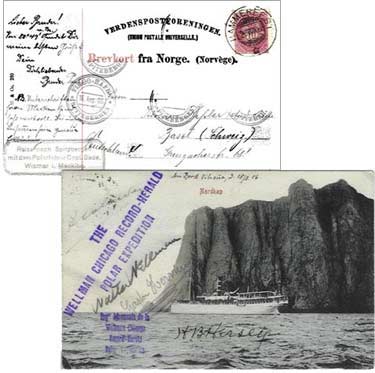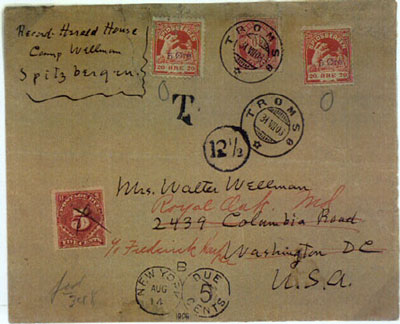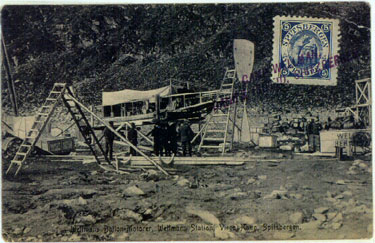The Wellman Expedition
What
words go into these letters we collect -- what does a man write to
his wife at a time of great decision? These questions are the reason
we value our collections and prize these pieces of paper.
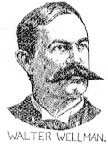 Walter
Wellman, who had spent a lifetime reporting news, was pressed by the
desire to make news by conquering the North Pole. He started his operations
from Spitzbergen in 1893. His foe was a hard one and he returned after
the first year certain that the only successful attainment of the
pole would be through the air. He advocated a balloon flight from
a point near Spitzbergen - and only a chance of fate caused him to
miss the financial backer he sought. Two years later Salamond Andree
advanced the same plan and flew to his death.
Walter
Wellman, who had spent a lifetime reporting news, was pressed by the
desire to make news by conquering the North Pole. He started his operations
from Spitzbergen in 1893. His foe was a hard one and he returned after
the first year certain that the only successful attainment of the
pole would be through the air. He advocated a balloon flight from
a point near Spitzbergen - and only a chance of fate caused him to
miss the financial backer he sought. Two years later Salamond Andree
advanced the same plan and flew to his death.
A
second land expedition was projected from Franz Josef Land in 1898
which was ended by an arctic phenomena - an ice quake. The quake struck
directly in the center of the camp and left the entire surrounding
area untouched. The party sadly gave up the endeavor and returned
to camp boasting only the conquering of 170 Arctic miles.
At
the Portsmouth Peace Conference in 1905 Wellman was attracted by the
French Lebaudy Dirigible Balloon. It was a motor driven, gas filled
dirigible with a lifting capacity of 7500 pounds; in this machine
he was sure he had found the vehicle in which he could attain the
top of the world.
An
unwieldy name, "Wellman Chicago Record Herald Polar Expedition"
was placed on the venture to favor his sponsor who underwrote the
required $250,000. The party occupied Andree's camp on Dane Island.
The workmanship on the new type of craft proved to be faulty and 1906
was spent entirely in testing and building. During the winter months
the craft was reconditioned and in 1907 the airship AMERICA
was finally inflated and assembled. It must have filled their hearts
with pride to see this craft, 186 feet long boasting a lifting capacity
of 19000 pounds with three Lorraine-Dietrich 80 horse power engines
capable of sustaining 18 miles per hour for 120 hours. The America
was second in size only to the GRAF ZEPPELIN.
The
newspapers were merciless in their attack on Wellman because they
labeled his trip as a publicity stunt and accused him of not intending
to make the flight at all. He resented this interference and fought
constantly to prevent their stories from influencing his plans.
Wellman North Pole Airship Expedition
|
|
Visitation
of Captain Bade's tourist ship, OIHANNA, that
season to Virgo Bay, Spitsbergen, annotated 18 August 1916
with that day's Virgo Bay, Spitsbergen "local" (tourist ship)
cancellation on front (also Hammerfest, Arctic Norway, August
1906, where it entered the postal system), with Wellman North
Pole Airship Expedition straight line cachet and autograph
of key Wellman expedition members Walter Wellman, M. Gaston
Hervieu (gas engineer) and Major Henry E. Hershey, in charge
of the expedition ship FRITHJOF. Postcard view
of Oihanna rounding North Cape, Norway, en route to Spitsbergen.
(Courtesy
of Herb & Janice Harvis)
|
|
|
Walter Wellman
used a semi-rigid dirigible in a 1909 attempt at the pole that
lasted three hours. Three years of testing and preparation were
expended and proved to be inadequate. Local stamps were ruled
invalid for international mail.
(Courtesy
of George Hall)
|
|
|
Cacheted
mailings were made from Camp Wellman during the long waiting
period.
(Courtesy
of George Hall)
|
The
year 1907 saw only a test flight which served to strengthen Wellman's
theories, the important factor in the successful completion of his
plans was the weather. The election year of 1908 passed by and he
returned to Spitzbergen again, without knowing of Peary's success.
He later admitted that he would not have returned had he known of
it. On August 15, 1909, he began the flight which ended in 70 miles
when the equalizer broke loose. The craft and crew were all saved.
Some
people ask what he accomplished or hoped to accomplish. The answer
is simply that he is one of a fraternity of men who refused to admit
that nature could best man in the polar regions.
"THE
ARCTIC FEVER IS IN OUR BLOOD AND THEIR IS NO CURE FOR SUCH PATIENTS
BUT TO PUT THEM ON ICE . . ."
WALTER
WELLMAN
(Except
where noted, exhibition pieces courtesy of George Hall)
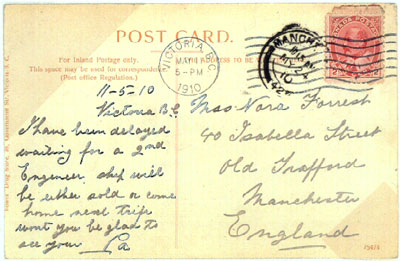
 Walter
Wellman, who had spent a lifetime reporting news, was pressed by the
desire to make news by conquering the North Pole. He started his operations
from Spitzbergen in 1893. His foe was a hard one and he returned after
the first year certain that the only successful attainment of the
pole would be through the air. He advocated a balloon flight from
a point near Spitzbergen - and only a chance of fate caused him to
miss the financial backer he sought. Two years later Salamond Andree
advanced the same plan and flew to his death.
Walter
Wellman, who had spent a lifetime reporting news, was pressed by the
desire to make news by conquering the North Pole. He started his operations
from Spitzbergen in 1893. His foe was a hard one and he returned after
the first year certain that the only successful attainment of the
pole would be through the air. He advocated a balloon flight from
a point near Spitzbergen - and only a chance of fate caused him to
miss the financial backer he sought. Two years later Salamond Andree
advanced the same plan and flew to his death.